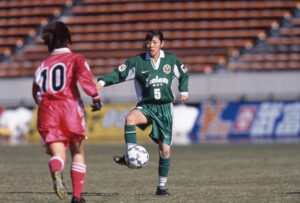“History of the Nadeshiko League”10. “Footsteps of Spring”
From the time when it was still unusual for women to play football, through to the birth of the Japan Women’s Football League, victory in the Women’s World Cup, and creation of the Japan Women’s Empowerment Professional Football League, social conditions and the environment surrounding girls’ and women’s football have undergone great changes.
We intend to publish a series of 22 articles before the end of the year in which we will look back over the tempestuous history of girls’ and women’s football in Japan.

Following the withdrawal of a number of supporting companies due to economic recession, the L. League (the current Nadeshiko League) divided into the East and West leagues in 2000, and after that was split into a league for the upper-placed teams and a league for the lower-placed teams. The aim was to save on teams’ travel expenses for away games. Having been launched in 1989 and at one time being a destination for world-class stars, the L. League was now faced with a crisis of existence and it adopted this format in an effort to simply survive.
The players continued to work hard, sometimes playing games on practice grounds without charging admission fees and completely out of the public eye. It may seem hard to believe now, but this was an age when the large majority of people expressed surprise at the idea of girls and women playing football.
In these circumstances, it was “Nippon TV Beleza” that led the league. The club struggled for funding due to the withdrawal of backing by the major distribution company Seiyu, which had supported it between 1994 and 1997, however, it maintained an excellent environment with access to the practice facilities used by the J. League powerhouse Verdy, enabling its players to see professional male players at first hand and receive guidance from the best coaches. Above everything else, the source of Beleza’s strength lay in its youth development team “Menina”.
As was introduced in the fifth installment of this series, in 10 years following its establishment in 1989, Menina produced a succession of talented players who carried Beleza.
Beleza became champions for the first time in seven years in 2000. In addition to the MVP Ayumi Hara, best-eleven members Yayoi Kobayashi, who was also the league’s top scorer, Mai Nakachi and Tomoe Sakai were all Menina graduates. Based around these members and other development team graduates such as Kanako Itoh, Shinobu Ohno and Eriko Arakawa, Beleza won three consecutive championships from this year onwards.
These players successively made their debuts for the Japan national team, and at the 2004 Athens Olympics, which became a major turning point in the history of women’s football in Japan, eight out of 25 the candidate players for the national team were Menina graduates. Above all else, “development” provided the driving force in ending the “winter years” and bringing on the “footsteps of spring”.
Around that time, another club that achieved considerable success through “development” was “Yokosuka Seagulls” in Kanagawa Prefecture. This team was the forerunner of “NHK SPRING YOKOHAMA FC Seagulls”, which plays in the first division of the Nadeshiko League today. In those days, the team was playing in the Kanagawa Prefectural League and Kanto League, and the club representative Mr. Masao Mori made it a policy to focus energy on developing players of junior high school age, and under the passionate coaching of Katsuaki Kameda, the club produced a number of players such as Yukari Kinga, Emiko Yamamoto and Kyoko Yano who went on to become key members of the Japan national team. In the L. League, Kinga played for Beleza; Yamamoto became the fulcrum of TASAKI Perule F.C.’s offense; and Yano played at university before embarking on a long career with Urawa Reds Ladies in the Nadeshiko League from 2007.
Having started the 2000 season with nine teams divided into the East and West leagues, the L. League increased to 10 teams with the addition of “Shimizudaihachi Sports Club” in Shizuoka Prefecture (the current Shimizudaihachi Pleiades of the Tokai League) in 2001. Also in 2001, “AS Elfen Sayama FC” of Saitama Prefecture (the current Chifure AS Elfen Saitama of the WE League) joined, and “Ohara Gakuen JaSRA Women’s Soccer Club” (the current AC NAGANO PARCEIRO LADIES of the WE League) and “Okayama Yunogo Belle” (currently in the second division of the Nadeshiko League) were added in 2003 to bring the total number of teams up to 13. Moreover, in 2004, the decision was made to add “ALBIREX NIIGATA LADIES” (currently in the WE League). At this time, the L. League was restored to a year-round nationwide format, and the league was divided into two divisions comprising Division 1 (L1, eight teams) and Division 2 (L2) for the first time.
The “footsteps of spring” could now clearly be heard amidst the warming rays of the sun.
Yoshiyuki Osumi (football journalist)






